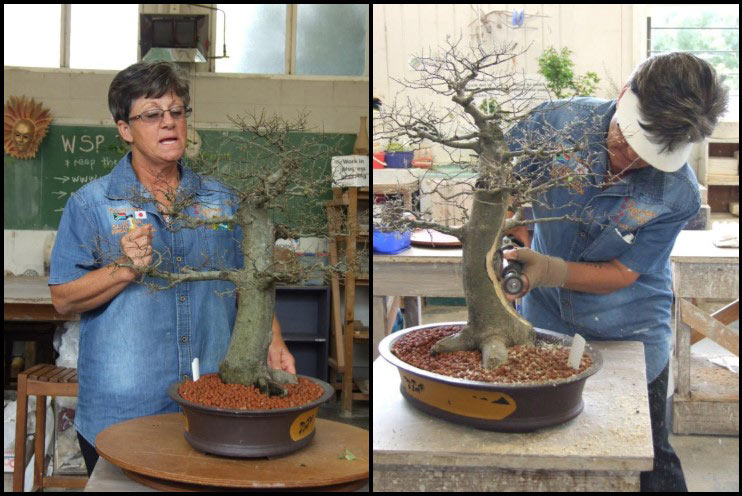

Kathy Steyn Saikei Workshop
April 13, 2019 @ 9:00 am - 4:30 pm
Topic: Kathy Steyn Saikei Workshop
Workshop with Kathy Steyn from South Africa on creating your own Saikei. A list of materials required will be circulated before the workshop.
The Workshop will be held at the Waikato Potters Society located at:
Studio 1 Ward Park Art Centre, 2 Seddon Road ( Corner of Ward and Seddon Road)
Prices:
Workshop Participant $40
Observer $20
Limited Places are available, you place is only secure once you have filled out the registration form AND paid in full.
9 Workshop Participant places
5 Observer places
A list of useful materials
Large flat pot, a good sized shallow tray will work. Saikei are usually planted into a shallow pot- rectangular or oval will do. Drainage holes will make tree watering a lot easier, but are not totally necessary. If you have access to a drill and a large bit, you can probably drill holes in the container. Check out Op Shops, garden centres, David’s Emporium, $2.00 shops, etc.
If your container has drainage holes, you will need mesh to cover these and wire to hold the mesh in place. If you use the sticky Gib board mesh, make sure it is well stuck down.
Interesting rocks of different sizes, can be of the same materials or mixed as long as they give the look you want and fit well in your pot. Landscape places usually have rock selections. Lots of rocks or just a few- up to you. But, lots of rocks also means heavy.
Soil- your usual potting mix, that is suitable for the species of trees you are using.
Small trees. Size and number depend on the the size of your container. A variety is fine, or of different sorts if they look well together. It is, however, important for the selected trees to have similar needs in care- water, amount of sun. nutrients, etc. It’s too late to start cuttings. Small trees in little pots can be purchased at some garden centres cheaply- Palmer’s especially. I will have a large number of lonicera available at the next meeting for $1-$2.00 each.
Small plants, moss, lichen, etc. These want to compliment the trees and rocks, and be in proportion, smaller than the trees. Again, care requirements must fit with the trees. If you want the trees to eventually grow a little larger, the complimentary plants must be of a type to keep quite small.
Different sizes and colours of decorative stones to be attractive and represent different textures in your planting. Garden centres usually have an assortment of gravels, and places that sell fish aquarium supplies will also.
Fine white sand- silica sand is ideal. Available at places that sell filtering materials, aquariums, Animates, Pottery supplies. And probably others. This would represent water in your Saikei.
If you want a path or road in your Saikei, well sifted river sand is excellent, or some other fine gravel/sand of quite uniform colour.
The end result wants to be pleasing, not crowded. Often, less is more.
You may want some means of attaching the rocks to your pot/tray- muck, Knead it, Blu Tack or some other stuff can be very helpful. Glues may work but you may not be able to make any future alterations. If your rocks are of a soft material you may be able to rasp them smooth on the base, so they are as flat as possible, etc. If they are hard the goop process may be the best bet. Remember, you will have to transport your creation home, and the last thing you want is for it to fall apart!
If all of this seems a bit much to handle, just do what you can do.
I mentioned at the meeting the need to do some homework before the workshop. You should arrive with a reasonable idea of what constitutes a Saikei, and definitely an idea of what you want your planting to look like when completed. Google “Saikei” and cruise through the offerings. Our library has quite a number of books that delve into the interesting and fun world of Saikei also. I hope to have them separated out for the March meeting. Once you have thought out what you want to end up with, play around with positioning, but don’t do any final pruning of your trees until they are planted.
A small cheap flat paintbrush, about 2c cm across is useful. bring tools to deal with the trees roots and for pruning once the trees are in place ( not always a good idea to have the trees perfectly pruned in advance as the final positions may end up different to what you first thought.
The materials you bring should be ready to assemble. It can take some time to assemble a Saikei that looks quite natural, but if you do your homework, and visualise what you want , and arrive with your material ready to use, you will have more time for the fun part!
